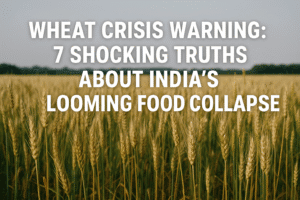Wheat Crisis Warning: 7 Shocking Truths About India’s Looming Food Collapse
A groundbreaking study reveals that despite farmers’ adaptations, climate change will severely cripple global food production, with India’s wheat heartland facing catastrophic losses of 40-100% by 2100 under high emissions. Every additional degree of warming reduces daily calorie availability by 120 per person globally. Adaptation efforts can offset only one-third of projected losses, offering least protection for wheat—the most vulnerable staple.
Wealthier breadbasket regions face steeper average declines (41%) than poorer areas (28%) due to exposure from intensified farming and shifting optimal growing zones. This threatens global calorie supplies disproportionately, as major producers like India, China, and the U.S. dominate output. Meanwhile, subsistence farmers relying on cassava risk devastating hunger. The research underscores that agricultural adaptation alone is insufficient without urgent emissions cuts to prevent systemic food crises.

Wheat Crisis Warning: 7 Shocking Truths About India’s Looming Food Collapse
The stark warning from a landmark Nature study isn’t just another climate change forecast—it’s a seismic tremor through the foundation of global food security. While farmers worldwide are already adapting, the research by the Climate Impact Lab reveals a harsh truth: adaptation alone is a bandage on a hemorrhaging wound, especially for India’s vital wheat belt. Here’s the deeper, human story behind the alarming statistics:
The Devastating Math of Warming on Your Plate:
- Every Degree Costs: Each 1°C rise in global temperature translates to a loss of 120 calories per person, per day—roughly equivalent to skipping a chapati or a small bowl of rice daily. That’s a 4.4% cut in current consumption, globally.
- India’s Wheat Heartland in the Crosshairs: Northern and central India emerge as global epicenters of projected losses. Under high emissions, these regions face potential wheat yield collapses of 40% to a catastrophic 100% by 2100. This isn’t just an economic blow; it threatens a dietary staple for hundreds of millions.
- Adaptation’s Limited Shield: Farmers aren’t passive victims. They are changing practices. Yet, this immense effort is projected to offset only about one-third of climate-related losses by century’s end if emissions remain high. The system is fundamentally stressed.
The Unequal Burden & the Adaptation Paradox:
- Breadbaskets Battered: Surprisingly, the study predicts the steepest average losses (41%) in the wealthiest agricultural regions—modern “breadbaskets” like the US, Canada, Europe, China, and crucially, India’s Punjab and surrounding states. Why? These regions currently enjoy near-optimal conditions; even small temperature increases push them beyond critical thresholds. Modern, high-yield systems are paradoxically more vulnerable to disruption.
- The “Risk-Taking” Effect: As regions develop (higher GDP), wheat farmers often increase investments and intensify production, making them more exposed to weather extremes – a dangerous gamble in a warming world. This dynamic exacerbates losses.
- Subsistence Suffering: The poorest regions face a different nightmare, averaging 28% losses. Their heavy reliance on cassava – a crucial but vulnerable staple – makes them disproportionately susceptible to climate shocks, risking famine.
Crops Under Fire: A Nuanced Picture:
- Wheat: The Canary in the Coal Mine: Faring the worst globally. Beyond India, expect significant losses (30-40%) in other major producers like China, Russia, the US, and Canada. Adaptation offers the least relative benefit for wheat.
- Rice: A Glimmer of (Cautious) Hope? Rice shows some resilience, tolerating higher minimum temperatures. There’s a 50% chance global yields could even increase with warming, and adaptation potential is highest for rice (offsetting up to 79-86% of losses).
- Maize & Soybean: Significant losses projected, but adaptation (especially in places like South America) can offer substantial mitigation.
- The Thermal Sweet Spot Disappears: Regions with historically “moderate” temperatures (like many current breadbaskets) face the largest yield drops. Hotter areas have some existing heat adaptation, colder areas initially benefit slightly, but the middle gets squeezed hardest.
Why This Matters Beyond the Farm Field:
- Global Calorie Crunch: The losses in high-yield breadbaskets have an outsized impact on global calorie production. A 40% loss in Punjab doesn’t just affect India; it ripples through world markets and food aid.
- Compounding Crises: This isn’t happening in a vacuum. Geopolitical instability (like the Ukraine war’s impact on wheat) and ocean warming harming fisheries (per IUCN) create overlapping vulnerabilities. Climate change is a threat multiplier.
- The Limits of Human Ingenuity: Farmers are resourceful, but this study quantifies the hard ceiling on what adaptation can achieve against unmitigated warming. Technological fixes alone won’t suffice.
The Path Forward Demands More Than Adaptation:
The study is a deafening alarm bell. It underscores that while supporting farmer adaptation is essential (crop diversification, water-saving tech, heat-tolerant varieties), it is utterly insufficient without parallel, aggressive action:
- Slashing Emissions NOW: Every fraction of a degree avoided lessens the blow. High emissions vs. moderate emissions scenarios show drastically different outcomes.
- Transforming Food Systems: Diversifying diets, reducing waste, investing in resilient alternative crops (beyond the big six), and strengthening local food networks are critical.
- Global Equity in Solutions: Support for adaptation must flow to both high-vulnerability breadbaskets facing collapse and subsistence communities dependent on staples like cassava. Their challenges are different but equally urgent.
- Rethinking Agricultural Development: Strategies focused solely on maximizing yields in current breadbaskets without building in climate resilience are setting up for failure. Development must prioritize sustainability and risk reduction.
The projected decimation of wheat yields in northern India is a dire warning shot for global food security. It reveals a system pushed to its breaking point, where even the best efforts of the world’s farmers cannot fully shield us from the consequences of unchecked climate change. The time for incremental adjustments is over. This study demands a fundamental reimagining of how we produce, distribute, and value food on a warming planet. The stability of our dinner plates depends on it.
You must be logged in to post a comment.